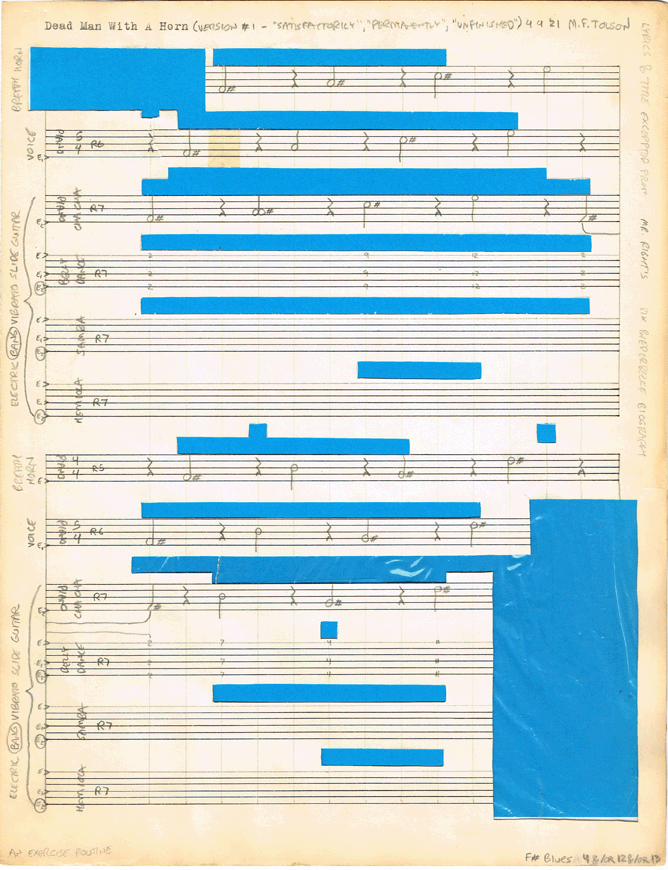
Dead Man with a Horn

This is my very 1st (m)usical (d) composition. I started working on it in the summer of 1974 when I was living in a house in Manhatten Beach, Maryland, on a tributary of the Magathy River. The house, because of its musician occupants, was supposedly called "La Mancha" by neighbors. I don't think it was intended as a compliment. I was 20 when I started this.
I believe I got to the point of its being ""Satisfactorily", "Permanently", "Unfinished"" (as it says on the top of each score page), on December 4, 1974. The date, also at the top, reads "4 4 21". I was experimenting with dating systems at the time & this was a personal date possibly meaning: the 4th day of the 4th month of my 21st year. If I started my 21st year on my 21st birthday, September 4, 1974, then the 4th day of the 4th month could either be December 4th or December 8th. It could also mean April 4, 1975, but I think that's too late.
The title & libretto are excerpted from "Mr. Right's Bix Biederbecke Biography". I remember that as a short poem inspired by another Bix bio called "Young Man with a Horn". Mr. Right = Brian Wolle = Herr Brain Storm Drain. The full text used, which is spread out over 12 pages, is:
"feel here there 9teen03 find atmosphere music find standards ideal find cornet simultaneously realize you will share travel jazz acceptance music lodge thrust achieve your popularity grows hanging ten on a lava river you're going too fast and you're not looking where you're going cascade the survivors blow taps they nail your box shut wait not without my horn nail drop cover blow sleep horn awaken"
This score is the 1st one in the "Detane Showpiece? < Why Bother?" folder in the "Excerpt(s) From: &/or 4 Retiring _" expanding folder wallet.



The "Excerpt(s) From: &/or 4 Retiring _" wallet has a fair amount of enigmatic &/or incoherent notes in it that I don't have the energy to revisit thoroughly at the moment. Instead, I'm scanning & perusing the contents piece by piece. "Dead Man with a Horn" is not only the earliest piece in the "Detane Showpiece? < Why Bother?" folder in the "Excerpt(s) From: &/or 4 Retiring _" expanding folder wallet, it's also the most important one from the collection that I'll try to explain in these online pages. I've already made explanatory pages for other pieces in the "Detane Showpiece? < Why Bother?" folder called "the sauce" & "STAIN" which were (d) composed & added slightly later.
As I recall, "Excerpt(s) From: &/or 4 Retiring _" was a collection of pieces meant to be somehow performed as a whole. The collection includes some 'impossible' (or unlikely) pieces such as an instruction to encircle the Earth at its equator with replicas of the New York Woolworth building (something scheduled to be declared a readymade by Marcel Duchamp - which he apparently never did (or I've forgotten that he did)). These replicas were to be placed on their sides end-to-end tops-to-bottoms. The 'performance' element was to explode them all. I don't remember whether the original instruction called for the replicas to be to scale. If not, ecodisaster might be avoidable by having the replicas be tiny. At any rate, the idea was that if that part of "Excerpt(s) From: &/or 4 Retiring _" wasn't performed then none of it should be. A film I made in collaboration with Marshall Reese:
[005. "Collaboration w/ Marshall Reese" [discarded]
- super 8
- app. 3:00
- fall '78]
was put in the wallet but I pulled it out & discarded it. That's a classic "GEE, I wish I hadn't done that." instance. The film featured the 2 of us in an apartment I lived in in Baltimore in the fall of 1978 where I cut up all the frames of "Mike Film" amongst other things. One or both of us wore my "Suggestion Box" sculpture over their head & a typewriter (that I still have) was somehow involved.
I remember even less about my intentions with "Detane Showpiece? < Why Bother?". On 2 stapled-together typewritten sheets (shown below as the next scan) the collection of work in the folder is apparently grouped together under "...detane showpiece" & is to:
1 begin with Dead Man With A Horn
The 2nd typewritten (& handwritten) page gives a simple list of contents that seems to begin with "2" - which might mean that the above is "1" even though it appears to be the same as "2":
2 Dead Man With A Horn - realization based on otherwise notes
3 &/or a showpiece for retiring _____/denated
4 Detane (temporarily, at least)
5 The Plastic Box Contents Etc (temporarily, at least) [handwritten addition]
6 Bi-Monthly (temporarily, at least)
7 Roll Expectations - Copulatory Muzak
8 piece for voices & drums (temporarily, at least)
9 end (round?) with Dead Man With a Horn
Saucy & Stain - Crab Feast things...
Location chosen X Realizer
(between 2 & 9)
"the sauce" & "STAIN" were added after the typewriting. The "X" means "by" (as in a measurement) & that ball-point pen addition just means "the sauce" & "STAIN" could be put anywhere between the 2 "Dead Man with a Horn" 'bookends' (but probably with "Saucy" 1st & "STAIN" after it since the sauce is presumed to be the cause of the stain.


"Dead Man with a Horn" is further kept inside music notation paper used as a folder. Inside the "Detane Showpiece? < Why Bother?" folder but right before the actual "Dead Man with a Horn" folder there are more typewritten & handwritten notes specific to "Dead Man with a Horn". These notes are on scraps that're stapled together. A handwritten note in blue ballpoint ink is on the back.


These notes specify that "Dead Man With a Horn" is "permanently unfinished" "temporarily at least" - immediately deliberately creating a potential (humorously intended) contradiction between the "permanently" & the "temporarily". The notes also specify that they're providing "requirements for both versions (lazy & otherwise) underlined". There doesn't appear to be a "lazy" version. The next line specifies that there're "NO LYRICS".. &, yet, there are.
The parts that're checked are apparently the things that I eventually built into "Dead Man with a Horn". Past these the notes state that "breath cornet is louder than guitar", further down still it provides what's purported to be a "Bb cornet range: e[sub]1 - e[sub]0 - e[super]1 - Bb". The cornet range is written as F#3 - F#6, the actual pitches played are E3 - E6. If I interpret my original "e[sub]1" as the E below Middle C, "E3", that would be correct. However, it seems that I was under the impression that the cornet range was only either 2 octaves, E3-E5, or 2.5 octaves, E3-Bb5. This is unclear to me, either way it's wrong but doesn't effect the part.
Written above this incorrect cornet range in blue ballpoint ink is written: "BREATH HORN 2 b played X Mr Right only". The reason for choosing cornet was that Bix Beiderbecke played it & so did Mr. Right, the friend who wrote the poem that inspired the title for this piece & provided the libretto. I no longer impose the restriction of Mr. Right being the only player OR of the instrument being a cornet. Given that the trumpet has the same range, a trumpet will be fine as a cornet substitute.
As for what a "Breath Horn" is?: The idea was to breathe loudly through the horn instead of blowing through it but still playing the specified pitches. If this has to be accomplished by breathily singing through the horn that's fine.

The front top of this notation paper used as a folder has 6 paper-clips attached. These are for attaching the 3 overlays to the base score.
There are further typewritten & handwritten notes specific to "Dead Man with a Horn" inside this notation folder.

These notes are a bit less rough. The 3 columns at the top left show the possible permutations of overlay page positions. A handwritten note adds "X variations between players". Not long after I created "Dead Man with a Horn" I created "decomposition". The calculations for overlay possibilities are also shown for that with that "decomposition" score. The notes go on to say:
duration of each: app. 7 minutes
total duration: app. 27 X 7: 189 minutes
Apparently the idea was to play all of the possible versions back-to-back. However, that doesn't take into consideration the "variations between players" mentioned as an afterthought. What would that be? 27 to the 9th power (9 players)? 7,625,597,484,987. That would then be multiplied by 7 (minutes) to equal a duration of 3,379,182,394,909 minutes. That would be a mere 127,093,291,416.45 hours duration. That, in turn, yields 5,295,553,809.01875 days. That's roughly 14,508,366.60005137 years or 145,083.6660005137 centuries. Might as well make that 14,508.36660005137 millenia, eh?! & you thought the Ring Cycle's a big deal. I think I'll settle for one performance at a time.
As far as I know, I embedded Morse Code in the score inspired by Lukas Foss's "Baroque Variations". Alas, I'm not sure HOW I did so & my incomplete attempt to decipher this, as marked in pen on the back of the above typed & handwritten notes, made in November, 1994, was an obvious failure:

This piece being the precursor for "decomposition" there are many things in common. The instrumentation is:
metronome
Breath Horn
voice
3 electric pianos
4 electric bang vibrato slide guitars
"decomposition" keeps the same instrumentation minus metronome & the electric pianos. It's possible that a performance of "decomposition" might bring the metronome back. Otherwise, for that, there might need to be a conductor acting as a metronome or a click track for the players to listen to via headphones or earbuds.
"electric bang vibrato slide guitar" means a solid body electric guitar with a vibrato bar that's used to have its tip strike the low E string (in this case) in order to make it sound. This is the technique used for the bottom 3 guitars (in terms of where they appear in the notation) but NOT the top one so the score is incorrect to call all 4 guitars by this name. The D string is to be tuned up one whole note to the "E" between the low E string & the high E string.
As with "decomposition" there're 13 base pages in the score but unlike "decomposition" there're only 3 overlays. These are to be put over pages 4, 12, & 13.
What I'll call the 1st of these overlays, marked "F# blues" in the bottom right, is shown below. I put bright blue paper behind it when I scanned it so that the cut-outs are more visible than they would be otherwise.

One can see that the 3 electric pianos each share a score with the Breath Horn, the voice, & the 1st of the guitars. As such, they only serve to enhance the timbre. Looking at the 1st page of the base score is even more informative:

Note that there's a metronome marking in the upper left designating a quarter note to equal 40 Grave. That's the slowest tempo marked on my Seiko metronome that I've had since I was a teenager.
In my tempo analysis of "decomposition", the webpage for which I created before this one, I wrote:
There're no measure lines. Instead there're vertical lines that function as regular beat markers. All notes are placed on these lines. There're no tempo markings but it's written in notes that the piece's duration is 6:30. Since there're 13 pages, that makes each page approximately :30 long. Given the sparseness of what I'll call "beat lines" that makes the tempo slow. E.G.: page 1 only has 20 beats. That makes each beat 1.5 seconds long.
That, however, isn't correct because the average number of beats per page isn't 20.
page 01 has 20 beats
page 02 has 20 beats
page 03 has 25 beats
page 04 has 25 beats
page 05 has 22 beats
page 06 has 25 beats
page 07 has 25 beats
page 08 has 19 beats
page 09 has 25 beats
page 10 has 24 beats
page 11 has 27 beats
page 12 has 25 beats
page 13 has 25 beats
20 + 20 + 25 + 25 + 22 + 25 + 25 + 19 + 25 + 24 + 27 + 25 + 25 = 307 beats TOTAL
It's probably hard, even for me, to resist the temptation to find much of this to be 'random' - but knowing myself as I do, & knowing how meticulous I was in the writing that I was doing at the time, there's probably an intricate schema at work here that I'm not remembering, some hidden meaning. I was still very close in age to my roots as a child mathematician.
At any rate, with 307 beats occurring over 390 seconds, that makes 1.270358306189 seconds per beat. I doubt that there's any good reason for the beat duration to involve such a long decimal statement so I think that 1.25 (1 & 1/4) seconds is probably fine. That would make 6 minutes & 21 & 1/4 seconds total duration. It's probable that the 6:30 duration was an estimate or a rounding off.
Since each beat is a quarter-note long, that makes the tempo 48 beats per minute. That puts the piece in the Largo tempo range (broadly - 40 to 60 BPM). It seems probable to me that I chose that tempo because I had heard Charles Ives's "Largo" (from the "Pre-First Sonata" (ca 1901)) as played by Louis Zukofsky & Gilbert Kalish in early 1975 & loved it. The robustness of Zukovsky's tone had particularly impressed me & seemed extremely appropriate for the piece.
HOWEVER, now that I'm looking at this earlier "Dead Man with a Horn" score I'm realizing that the above is partially incorrect (& will have to be changed or addended to on the "decomposition" webpage.
Instead of choosing the tempo "because I had heard Charles Ives's "Largo" (from the "Pre-First Sonata" (ca 1901)) as played by Louis Zukofsky & Gilbert Kalish in early 1975" I must've simply chosen it because it was the slowest tempo on my metronome - which I was planning to use in the piece. That Seiko metronome is now long-since broken & I have a working Seth Thomas metronome in its place that I got in recent years. The Seth Thomas also goes down as low as 40BPM & its last tempo marking is Largo but it's marked in such a way that the 40 seems lower than its range. Grave isn't written in this low range but the metronome's lay-out is such that there's no room for any more writing anyway. If "Dead Man with a Horn" & "decomposition" had been (d) composed in this era of household computers & applications with click-tracks I might've chosen an even slower tempo. Online I see that there's a Larghissimo which is very, very slow (19 beats per minute and under). I see online that there's a "Metronomics" application that goes from 1BPM to 500BPM & that there's a "Visual Metronome" app that goes from 1 to 800!!
Instead of having a substantial variety number of beats per page, as "decomposition" does, the 1st 8 pages have 26 beats, pages 9 to 12 have 24, & the last page, 13, goes back to 26. That makes a total of 330 beats. 330 beats at 40BPM makes this 8:20.
Making things more complicated &/or confusing to this day are what are intended to be accent marks. The Marcato (Italian for "well marked"), what I tend to think of as 'the hat' (en Français, le petit chapeau - the little hat) or 'the roof', an inverted "V" (a vertical wedge) over a note indicates that it's to be played somewhat louder or more forcibly than a note with a regular accent. Fine - but what about a Marcato combined with a presumed Tenuto, the horizontal line over the note? I don't think these notations are usually combined so my use of them will be deduced to mean play a note slightly longer than its full value somewhat louder or more forcibly than a note with a regular accent. HOWEVER, looking at the "Dead Man with a Horn" score that this is a direct outgroth of, I see that there's a key that identifies the Marcato as a "big accent" & the Marcato with a line over it as a "little accent". So be it.
This symbol key at the bottom of the 1st page of the base score also indicates that "R = Recording Volume" & "P = Playback Volume".
The base score pages have notes on them except for the ones that are meant to be covered with overlays: pages 4, 12, & 13. These pages have accents & "P" numbers only (i.e.: they're without pitches). P = Playback & these occur as periodic markings in a countdown. Therefore, "P10" (maximum playback volume) appears on the 1st vertical line, "P9" occurs on line 35, P8 on 65, P7 on 95, P6 on 125, P5 on 155, P4 on 185, P3 on 215, P2 on 245, P1 on 275, P0 on 305. Apparently, I stopped the vertical beat notation 2 beats short of page 12 just so that page 13 could start with "P0".
That means that there's this progression:
Start on maximum volume, lower volume 1 marking at the 35th beat, lower it again at 30 beats later, again 30 beats later, again 30 beats later, again 30 beats later, again 30 beats later, again 30 beats later, again 30 beats later, again 30 beats later, finally 30 beats later.
There are then 25 beats of sound turned off. But what do these Playback numbers mean?
Each part has an "R" number at the left of the page. The "R" stands for "Record" just as the "P" stands for "Playback". On page 1, the "R" numbers are:
BREATH HORN / PIANO = R5
VOICE / PIANO = R6
ALL ELECTRIC BANG VIBRATO SLIDE GUITAR / PIANO SIMULTANEOUS WITH TOP GUITAR = R7
This stays the same for page 2 but changes on psge 3 to:
BREATH HORN / PIANO = R7
VOICE / PIANO = R6
ALL ELECTRIC BANG VIBRATO SLIDE GUITAR / PIANO SIMULTANEOUS WITH TOP GUITAR = R5
Page 4 (in all 3 overlay instances) reverts to the original schema. THEN pages 5 through 11 return to the 2nd schema:
BREATH HORN / PIANO = R7
VOICE / PIANO = R6
ALL ELECTRIC BANG VIBRATO SLIDE GUITAR / PIANO SIMULTANEOUS WITH TOP GUITAR = R5
& the last 2 pages (both of which get overlays) return to the 1st schema.
This seems to encourage a record/playback realization for pre-recorded performance. Such a thing was no doubt inspired by the Nonesuch record of John Cage & Lejaren Hiller's "HPSCHD" because each record came with a unique computer print-out score for the person operating the record player to follow in order to make their playing of the record one-of-a-kind.
For "Dead Man with a Horn" &"decomposition" it isn't actually necessary to follow the instructions live given that the recording can be altered to meet the requirements. A way to not have the last 25 beats be silent would be to record all the parts line in & to record the last 25 beats with a microphone but only have the players make the motions rather than to play audible pitches - ambient sound would be heard.
The key also specifies "O's indicate which string to be banged". That means that the encircled Esub2 strings in the guitar tablature of the score (the bottom 3 guitars) are the only strings to be banged by the vibrato bar end. Even though it's unspecified, the only other 2 strings that are to be sounded should be finger-picked.
What is specified at the beginning of the score in the parts for the 3 bottom guitars is written in somewhat faint pencil between the staves. "Suggestions" are provided: the middle OR high Es are to be fingernail picked - that implies to me that the remaining string to be sounded would be plucked with the flesh of the finger - the fingernail pick would have a sharper attack; the lowest E of the middle of these 3 guitars is suggested to be played with a "fingernail scrape" - meaning that the winding of the string would be scraped - there would then be 2 activating motions: the vibrato bang & the scrape; the bottom of the 3 guitars is specified to have the middle OR high Es "picked close to the bridge" - the string to be chosen is whichever one isn't used by the upper guitar, "whichever isn't used in belly dance".
Unlike "decomposition", there are time signatures for the top 2 parts: the "Breath Horn / piano" & the "voice / piano". The Breath Horn / piano is in 4/4 & the voice / piano is in 5/4. Given that there are no measures, only vertical beat lines, & that the accents aren't oriented around time signatures, these 4/4 & 5/4 markings are totally 'senseless'. The intentionality of this 'senselessness' is further exaggerated by having each of the guitars marked as playing 'decadent' dances: "Cha-Cha", "Belly Dance", "Samba", & "Hemiola" (not strictly a dance but associated with the 'Mexican Hat Dance'). "decomposition" has the "Twist", "Charleston", "Tango", & "Strip Tease". Obviously, none of these rhythms correspond with their notes, rests, & accents.
There are no clef signs. Instead, I mark stave lines with either E, Esub1, or Esub2. "E" is E4 (the E above Middle C). The entire Breath Horn part is notated this way & is, therefore, in Treble Clef. "Esub1" is E3 (the E below Middle C) & is, therefore, NOT in Treble, Alto, or Bass Clef. If one imagines the Alto Clef as pointing to the 2nd space from the top instead to the middle line then this would be a correct usage of pre-Classical C Clef. Such deviations were especially common in vocal music. Since this is the vocal part it's not completely unorthodox. The guitar / piano part has the lowest line designated as Esub2, E2 (the E 2 octaves below Middle C). If one were to imagine the Bass Clef moved up to the top staff line that would make the top line F3 & the bottom line F2. There was a time when this F Clef rested on the middle staff line. In this position it was the Baritone Clef. I propose that the F Clef on the top line be called the Bass Chef.
Less humorously, but more practically, Octave Clefs could be used: the top stave would just be a Treble Clef, the next stave would be a Treble Clef with an "8" under it, & the 3rd stave would be a Treble Clef with a "15" under it.
"Dead Man with a Horn" starts off with the voice singing 3 Bb3s. Then the guitars enter on all 3 of the G#s in use (the single piano playing at this point playing only the G#2. In a slow echo the voice sings the G#3 a quarter later (on the next vertical beat line) (with, of course, its piano playing in sync) followed another quarter later by the Breath Horn / piano playing G#4. This section starting on G# is marked as the beginning of a "G# Pentatonic" section that's shown as lasting for 19 beats. G# Pentatonic is presented as consisting of G#, B, D#, F#, & C#.
On page 2 of the score, the modal "E Locrian" is presented as starting on the 27th beat. At beat 50, the 3# Whole Tone starts after the E Locrian has ended. With this scale change, the 'echoing' descends rather than ascends.

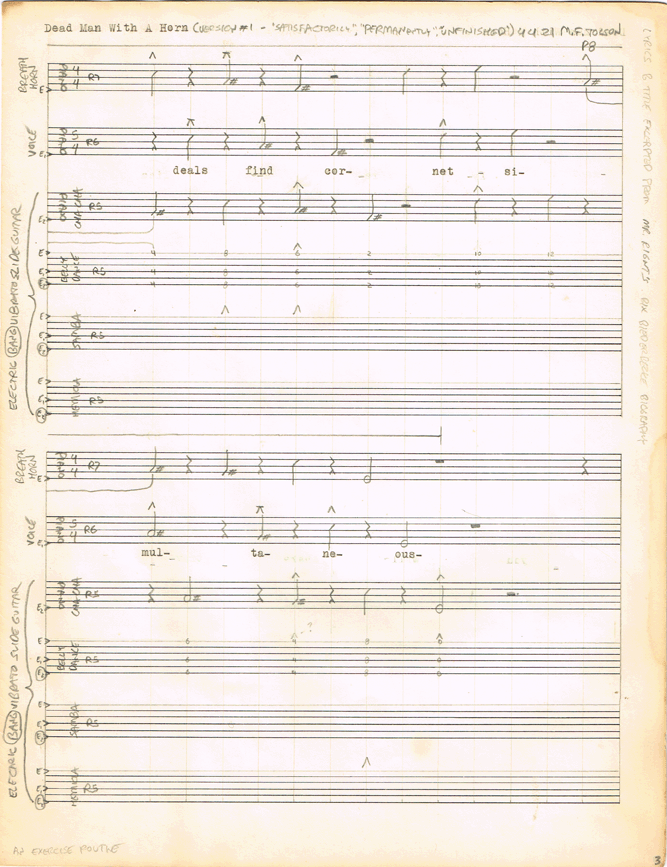
The pattern goes back to ascending with an overlay over base page 4.


The overlay pages. each have their own scales: "F# Blues", "F Harmonic m"[inor], & "D Mixolydian". Since they are interchangeable, any of those scales could be on pages 4, 12, & 13. After the 1st overlay, on base score page 5 (beginning at beat 103), the scale is specified as "Chromatic" & the descending starts again. Chromatic doesn't end until beat 137 on page 6. "E Natural m"[inor] starts on beat 138 & the descent continues. The E Natural Minor stops on beat 157 & "CM"[ajor] starts on beat 158.



C Major ends on beat 176 at the end of page 7. Page 8 begins on beat 177 with "A Melodic m"[inor]. That's followed by A# Lydian at beat 208 on page 9. Page 9 is the 1st of the 24 (instead of 26) beat pages. A# Lydian ends on beat 228 at the end of page 9. A Phyrgian begins page 10 at beat 229. C# Dorian takes over at beat 250 still on page 10. C# Dorian doesn't end until the 2nd beat of the next overlay page (beat 278). In the meantime, to my surprise, the echo direction reversed to ascending again during the C# Dorian section at beat 271 on page 11. It stays that way to the end.
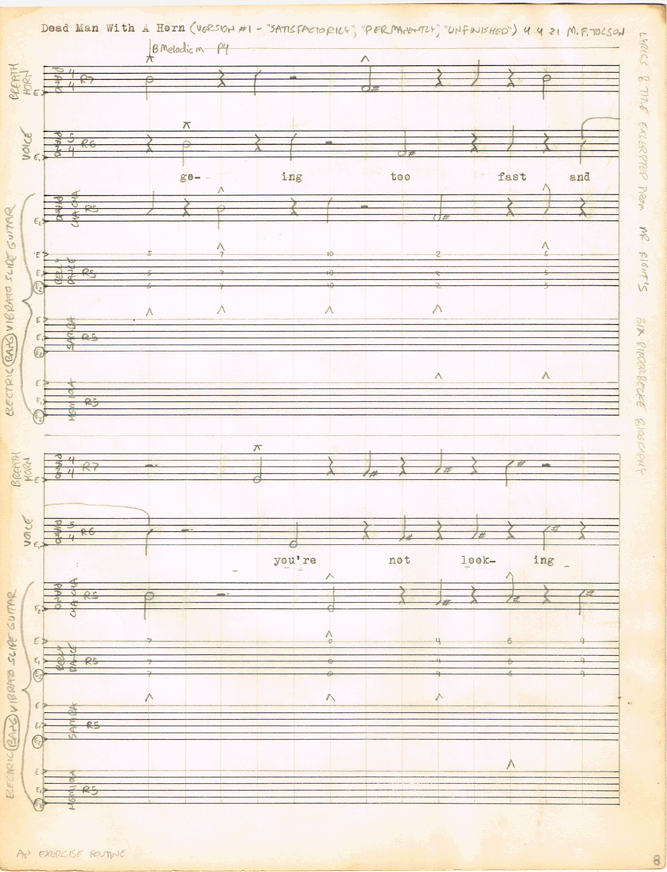
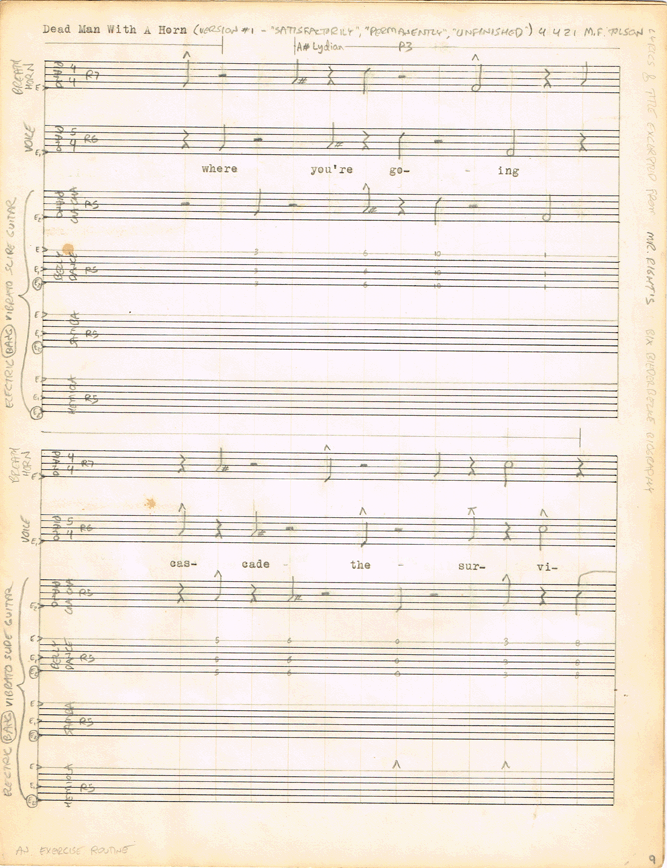


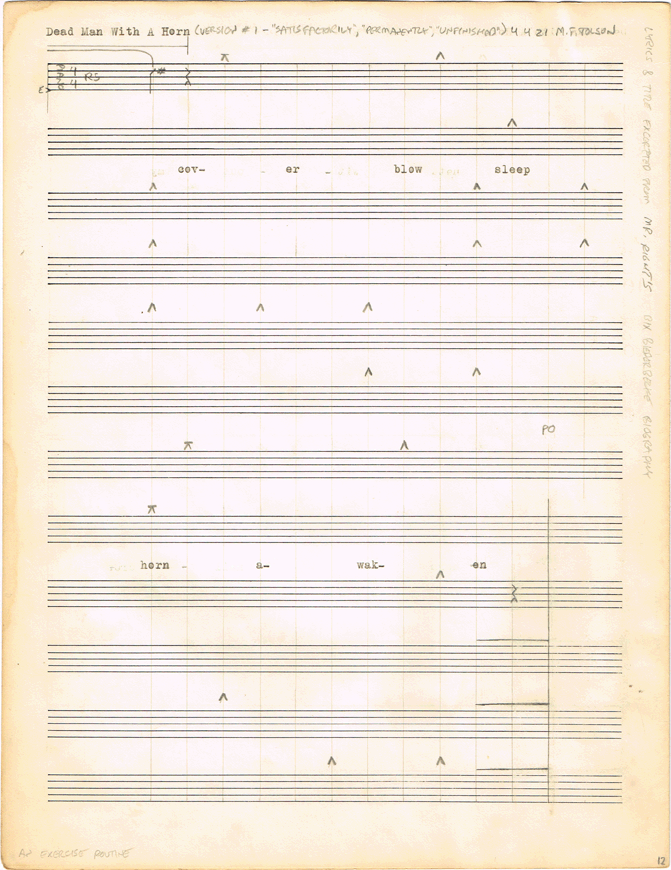

Here're the 3 overlay score sheets. The 1st one shown here (already presented earlier) is "F# Blues":

The next one, although it doesn't have to be in this order, is "F Harmonic m"[inor]:

& the last one, although, again, it doesn't have to be in this order, is in the D Mixolydian mode:

Now that I've spent some quality time examining this score possibly for the 1st time since I (d) composed it 45 years ago I'm impressed by how original it is. SOONER OR LATER IT WOULD BE NICE TO HEAR IT!!!!!
- August 30, 2019, explanatory notes from tENTATIVELY, a cONVENIENCE
idioideo at verizon dot net
to the tENTATIVELY, a cONVENIENCE (d) compositions index
to the tENTATIVELY, a cONVENIENCE Audiography page
to the tENTATIVELY, a cONVENIENCE as Interviewee page
to the tENTATIVELY, a cONVENIENCE as Interviewer index
to the tENTATIVELY, a cONVENIENCE movie-making "Press: Criticism, Interviews, Reviews" home-page
to the "tENTATIVELY, a cONVENIENCE - Sprocket Scientist" home-page
to the "FLICKER" home-page for the alternative cinematic experience
to find out more about why the S.P.C.S.M.E.F. (Society for the Prevention of Cruelty to Sea Monkeys by Experimental Filmmakers) is so important
for info on tENTATIVELY, a cONVENIENCE's tape/CD publishing label: WIdémoUTH
to see an underdeveloped site re the N.A.A.M.C.P. (National Association for the Advancement of Multi-Colored Peoples)